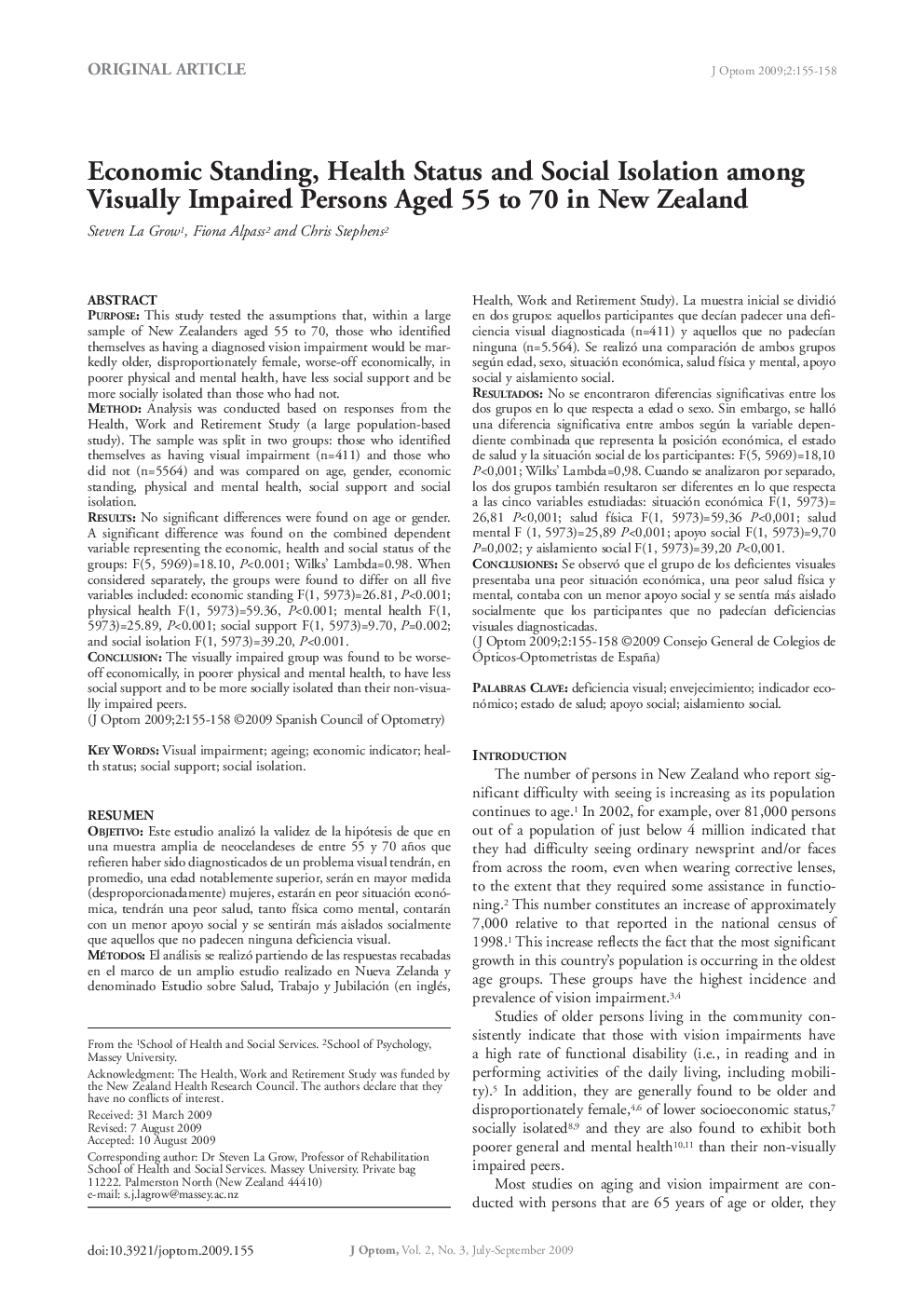| کد مقاله | کد نشریه | سال انتشار | مقاله انگلیسی | نسخه تمام متن |
|---|---|---|---|---|
| 2695243 | 1143734 | 2009 | 4 صفحه PDF | دانلود رایگان |

PurposeThis study tested the assumptions that, within a large sample of New Zealanders aged 55 to 70, those who identified themselves as having a diagnosed vision impairment would be markedly older, disproportionately female, worse-off economically, in poorer physical and mental health, have less social support and be more socially isolated than those who had not.MethodAnalysis was conducted based on responses from the Health, Work and Retirement Study (a large population-based study). The sample was split in two groups: those who identified themselves as having visual impairment (n=411) and those who did not (n=5564) and was compared on age, gender, economic standing, physical and mental health, social support and social isolation.ResultsNo significant differences were found on age or gender. A significant difference was found on the combined dependent variable representing the economic, health and social status of the groups: F(5, 5969)=18.10, P<0.001; Wilks’ Lambda=0.98. When considered separately, the groups were found to differ on all five variables included: economic standing F(1, 5973)=26.81, P<0.001; physical health F(1, 5973)=59.36, P<0.001; mental health F(1, 5973)=25.89, P<0.001; social support F(1, 5973)=9.70, P=0.002; and social isolation F(1, 5973)=39.20, P<0.001.ConclusionThe visually impaired group was found to be worse-off economically, in poorer physical and mental health, to have less social support and to be more socially isolated than their non-visually impaired peers.
ResumenObjetivoEste estudio analizó la validez de la hipótesis de que en una muestra amplia de neocelandeses de entre 55 y 70 años que refieren haber sido diagnosticados de un problema visual tendrán, en promedio, una edad notablemente superior, serán en mayor medida (desproporcionadamente) mujeres, estarán en peor situación económica, tendrán una peor salud, tanto física como mental, contarán con un menor apoyo social y se sentirán más aislados socialmente que aquellos que no padecen ninguna deficiencia visual.MétodosEl análisis se realizó partiendo de las respuestas recabadas en el marco de un amplio estudio realizado en Nueva Zelanda y denominado Estudio sobre Salud, Trabajo y Jubilación (en inglés, Health, Work and Retirement Study). La muestra inicial se dividió en dos grupos: aquellos participantes que decían padecer una deficiencia visual diagnosticada (n=411) y aquellos que no padecían ninguna (n=5.564). Se realizó una comparación de ambos grupos según edad, sexo, situación económica, salud física y mental, apoyo social y aislamiento social.ResultadosNo se encontraron diferencias significativas entre los dos grupos en lo que respecta a edad o sexo. Sin embargo, se halló una diferencia significativa entre ambos según la variable dependiente combinada que representa la posición económica, el estado de salud y la situación social de los participantes: F(5, 5969)=18,10 P<0,001; Wilks’ Lambda=0,98. Cuando se analizaron por separado, los dos grupos también resultaron ser diferentes en lo que respecta a las cinco variables estudiadas: situación económica F(1, 5973)= 26,81 P<0,001; salud física F(1, 5973)=59,36 P<0,001; salud mental F (1, 5973)=25,89 P<0,001; apoyo social F(1, 5973)=9,70 P=0,002; y aislamiento social F(1, 5973)=39,20 P<0,001.ConclusionesSe observó que el grupo de los deficientes visuales presentaba una peor situación económica, una peor salud física y mental, contaba con un menor apoyo social y se sentía más aislado socialmente que los participantes que no padecían deficiencias visuales diagnosticadas.
Journal: Journal of Optometry - Volume 2, Issue 3, 2009, Pages 155–158